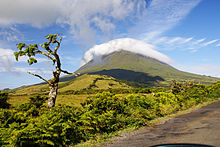Pico (island)
| Pico | |
|---|---|
| Pico seen from Horta on Faial | |
| Waters | Atlantic Ocean |
| Archipelago | Azores |
| Geographical location | 38 ° 29 ′ N , 28 ° 22 ′ W |
| length | 42 km |
| width | 15 km |
| surface | 447 km² |
| Highest elevation |
Ponta do Pico 2351 m |
| Residents | 13,834 (2016) 31 inhabitants / km² |
| main place | Madalena |
| The Pico highlands in October | |
Pico ( German "summit" ) is the second largest island in the Azores and is part of the Central Group ("Grupo Central dos Açores"). It was named after the 2351 m high volcano Ponta do Pico , the highest mountain in Portugal on the island . The island of Pico is 42 km long and 15 km wide, the area is 447 km². To the east of the Pico there is a plateau with smaller volcanic cones and craters on which larger herds of cattle are kept. About 14,000 people live on Pico.
geography
The island is located at 28 ° 20 ′ west longitude and 38 ° 30 ′ north latitude and is separated from the island of Faial , six kilometers away , by the Canal do Faial . In addition to the Madalena ferry port , located directly across from the island of Faial in the west, Lajes do Pico is a former whaling base in the south , and the city and port of São Roque in the north .
Pico and Faial are six kilometers apart. From the top of the mountain of the same name, one overlooks the entire island and also has a clear view of Faial and São Jorge.
history
At around 250,000 years old, Pico is the youngest of the Azores islands.
The Portuguese took possession of the island in 1439. The first settlers came to the island from 1460. They lived from growing grain and yams as well as from raising cattle . Later came the viticulture added. Eruptions of the Pico in 1562 and 1718 led to the partial emigration of the population. In the middle of the 19th century, viticulture was severely affected by powdery mildew . But whaling flourished and was an important source of income for the population for a century. In 1980 Pico was hit by a severe earthquake near Terceira . In 1981 Pico Airport went into operation.
administration
Pico is the second largest island in the Azores archipelago after São Miguel . It belongs to the Autonomous Region of the Azores and is therefore part of the national territory of Portugal .
The island is divided into three concelhos ( Portuguese districts), which in turn are divided into 17 freguesia (Portuguese municipalities):
- Lajes do Pico (with 6 municipalities)
- Madalena (with 6 municipalities)
- São Roque do Pico (with 5 parishes)
Sports
The football club Vitória Futebol Clube do Pico , founded in 1951, plays its home games in the Campo do Vitória Futebol Clube stadium in the small town ( Vila ) of São Roque do Pico, which has a capacity of 2,000 . The club plays at the association level of the Horta football association. The Prainha Futebol Clube , which has existed since 1988, also plays there . He comes from the municipality of Prainha and welcomes his guests in the 1,000-seat municipal stadium Campo Municipal de São Roque . (As of 2014).
The inline speed skating European championships in 1989 took place on the island.
Island specialties
The special vine cultivation was declared a World Heritage Site by UNESCO in 2004 . The island's wine was exported to the Tsar's court in Saint Petersburg in the 19th century . In countless small Adegas , not only the wine but also the self- distilled Aguardente is offered to this day. The cheese made on the island called Queijo do Pico is also known .

Whales
Professional whaling, which the islanders practiced in small boats with 10 to 20 rowers ("Botes Baleiros"), was given up in 1984, and in 1987 the last whale was caught. Today there are two whaling museums on Pico. One is in Lajes do Pico, the other, a restored "whale factory", in São Roque.
Pico is a center for whale watchers in Europe. Since 1985, Pico has developed an extensive gentle whale watching industry. Inflatable boats set off from Lajes and Madalena to observe the marine mammals. Madalena has specialized in trips to snorkel with wild dolphins.
In 2013, true whales were filmed underwater for the first time in the waters off the island .
Web links
- The portal of the Azores
- Azores
- Homepage of the Serviço Regional de Estatística dos Açores (SREA) (engl./port.)
Individual evidence
- ^ NA Dias, L. Matias, N. Lourenço, J. Madeira, F. Carrilho, JL Gaspar: Crustal seismic velocity structure near Faial and Pico Islands (AZORES), from local earthquake tomography (PDF; 3.35 MB). In: Tectonophysics 445, 2007, pp. 301–317 (English)
- ^ Profile of Vitória FC do Pico on www.fussballzz.de, accessed on January 24, 2015
- ↑ Natacha Aguilar de Soto et al .: True's beaked whale (Mesoplodon mirus) in Macaronesia PeerJ, March 7, 2017, accessed March 8, 2017.
- ↑ Filmed for the first time: Der True-Wal orf.at, March 7, 2017, accessed March 8, 2017.




